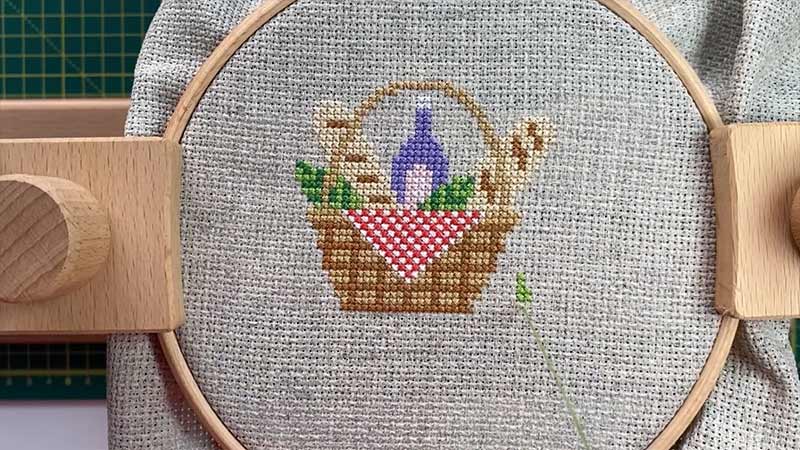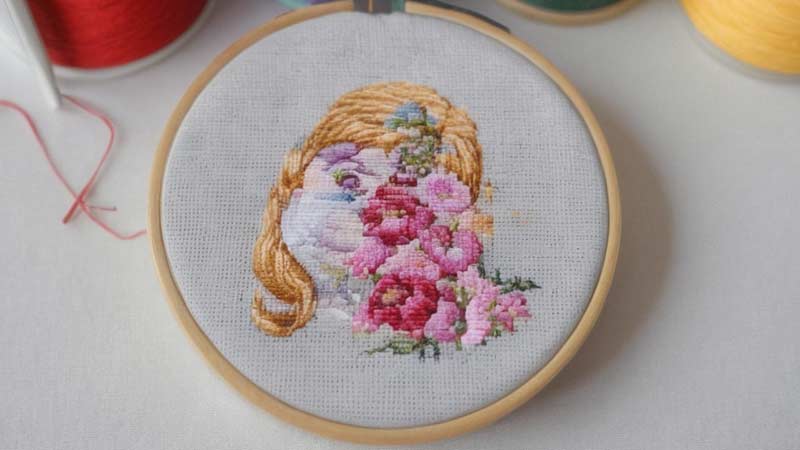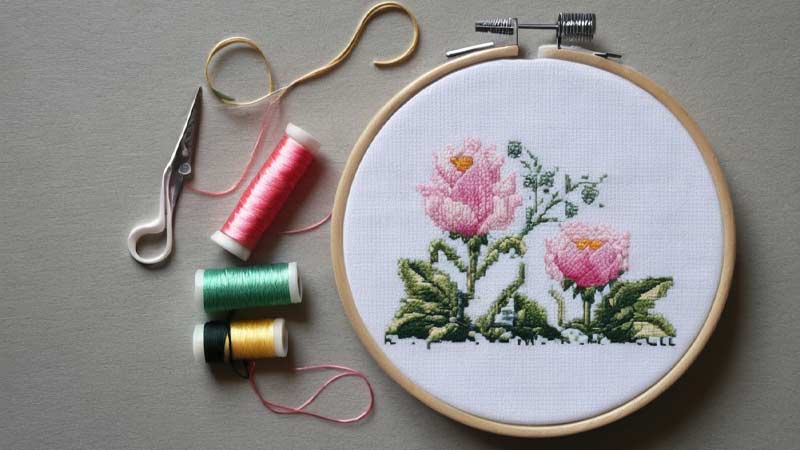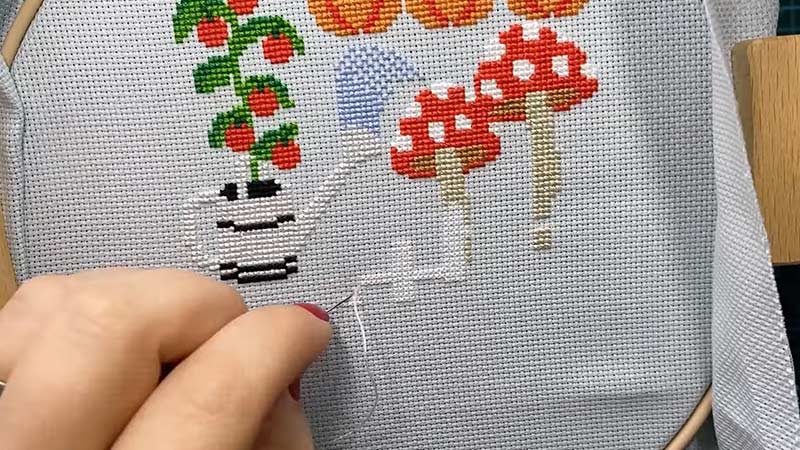Embarking on a cross-stitch project requires attention to detail, and one crucial element is often overlooked – the length of your embroidery floss.
Have you ever been entangled in a web of threads or running out before completing a section? Fear not, as we unravel the mystery of ‘How long should I cut my floss for cross stitch.’
The correct thread tension is the key to achieving clean, precise stitches without hassle. This guide will explore the factors influencing the ideal floss length, ensuring your needlework journey is smooth and enjoyable.
From the fabric count to the type of stitch and the size of your project, we’ll delve into the intricacies of determining the perfect length for your cross-stitch floss.
So, grab your needle, and let’s weave through cross-stitching with the confidence of knowing exactly how long your floss should be.

How Long Should I Cut My Floss For Cross Stitch?
Have you ever wrestled with a tangled thread or fretted whether you’ve cut enough for your project? Let’s unravel the mystery of the ideal floss length for cross-stitching.
Understanding the Basics
To grasp the concept of the perfect floss length, let’s start with the basics. The standard length for cross-stitch floss is approximately 18 inches (45 cm).
This length strikes a balance between being manageable and reducing the risk of excessive wear and fraying. However, various factors can influence whether you should cut longer or shorter strands.
Fabric Count Matters
The fabric count of your cross-stitch material is a critical determinant of the ideal floss length. Fabric count refers to the number of threads per inch in the fabric.
For higher fabric counts (e.g., 18 or 22), where the stitches are smaller and more intricate, a shorter floss length is advisable to maintain control and precision.
On the other hand, lower fabric counts (e.g., 11 or 14 counts) with larger stitches can accommodate slightly longer strands without compromising your stitching experience.
Stitch Type Considerations

Different cross-stitch patterns may involve various stitch types, and the type of stitch you’re working with can influence the length of floss you should cut. For basic cross stitches, the standard 18-inch length is generally sufficient.
However, if you’re incorporating specialty stitches or backstitching, you might want to cut slightly longer strands to accommodate the extra thread needed for these techniques.
Project Size and Floss Management
The size of your cross-stitch project also plays a role in determining the optimal floss length. Shortening strands may be more practical for smaller projects to avoid excessive tangling and wastage.
Conversely, larger projects may benefit from longer embroidery floss length, reducing the frequency of rethreading your needle and providing a more continuous stitching experience.
Floss management is another aspect to consider. If your project involves multiple colors or frequent color changes, cutting shorter strands can make the process more efficient and help you keep track of your thread inventory.
Planning and organizing your floss cross stitch colors can create a smoother stitching flow.
Tips for Deciding How Long to Cut Cross Stitch Thread
A sharp pair of embroidery scissors ensures clean cuts, reducing the risk of fraying and tangles. Keep your floss organized with a floss organizer, allowing you to access and manage multiple colors during your project easily.
Consider doing a small test section with your chosen floss length on a scrap fabric. Adjust the length based on your comfort and the specific demands of your project.
Be conscious of how you pull the floss through the fabric. Avoid yanking or pulling too tightly, as this can lead to thread breakage and distortion of the stitches.
Keep Records
As you gain experience with different projects, record the floss lengths you used and the outcomes. This can serve as a valuable reference for future projects and help refine your approach based on past successes and challenges.
What to Do If My Floss Is Too Small?

Encountering a situation where your cross-stitch floss is too short can be a common challenge, but fear not – several strategies exist to address this issue and salvage your project. Here’s a comprehensive guide on what to do if your floss is too small:
Assess the Remaining Floss
Before taking any corrective measures, assess how much floss you have left. You may not need to adjust if the remaining length is sufficient to complete the current section or reach the end of your stitching line.
Evaluate the Stitching Progress
Consider where you are in your stitching. Suppose you’ve just started a new section or are near the beginning of a line. In that case, it might be easier to rectify the situation without affecting the overall integrity of your project.
Extend the Floss with a New Strand
If your floss is too short to reach your intended stitching area comfortably, you can extend it by attaching a new strand. Knot the end of the existing floss securely to the fabric where it won’t be visible on the front side.
Begin a new strand of floss of appropriate length, leaving a small tail. Carefully weave the tail of the new strand through the stitches on the back of your work.
This technique, known as “weaving in,” helps secure the new strand without creating bulky knots. Trim any excess floss on both ends once you’ve woven in the new strand.
Use the Loop Start Method

To avoid knitting knots at the end of your floss, consider using the loop start method when starting a new strand. Fold the floss in half, creating a loop at one end. Insert the loop through the needle’s eye, leaving a small tail on the other end.
Bring the needle through the fabric and pass it through the loop to secure the floss. This eliminates the need for a knot and seamlessly integrates the new strand with the existing stitches.
Blend in the Transition
Consider how you blend the transition between the old and new floss when extending or attaching a new strand. Ensure that the stitches remain consistent and neat, disguising the point where you made the switch.
This attention to detail helps maintain the overall aesthetic of your cross-stitch project.
Prevent Future Shortage
To avoid the same issue, consider the following preventive measures. Develop a habit of estimating the floss length needed for a particular section before cutting. Over time, you’ll become more accurate in your estimations.
Maintain a record of the floss lengths used for different projects. This can serve as a reference point for future endeavors. When in doubt, cut a slightly longer strand than you need. Working with excess floss is more accessible than dealing with a shortage.
Practice Regular Floss Checks
Throughout your stitching process, periodically check the length of your floss. This habit helps you catch potential issues early on, allowing for timely adjustments and avoiding frustration later in the project.
Maintain a Calm Approach
If you are in a situation where your floss is too short, try to remain calm and approach the resolution methodically. Panicking or rushing may lead to mistakes that could be more challenging to rectify.
Embrace Imperfections
Finally, remember that imperfections happen to even the most experienced cross-stitchers. Embrace the learning process, and view challenges as opportunities to enhance your skills.
In many cases, the finished project will not reveal the minor adjustments made during the stitching process.
FAQs
How do I determine the right floss length for my cross-stitch project?
Consider factors such as fabric count, stitch type, and project size. Opt for shorter strands for higher fabric counts or intricate stitches, while larger projects may benefit from longer lengths.
Can I use the same floss length for all my cross-stitch projects?
While the standard length is around 18 inches, it’s essential to adapt the length based on the specific requirements of each project. Experiment with different lengths to find what works best for your stitching style and the intricacy of the design.
What can I do to prevent tangling and knots in my cross-stitch floss?
Invest in quality scissors for clean cuts, use a floss organizer to keep threads in order, and be mindful of how you pull the floss through the fabric. Techniques like the loop start method can also minimize the risk of knots.
How do I manage multiple colors efficiently during a cross-stitch project?
Utilize a floss organizer to keep different colors organized. Cut shorter strands for projects with frequent color changes to streamline the process and prevent tangles.
What should I do if I run out of floss during my cross-stitch project?
Plan and estimate the amount of floss needed for your project. If you run out, secure the end of the existing thread, start a new thread with a similar length, and weave the ends carefully to ensure a seamless transition without compromising the integrity of your stitches.
Conclusion
The length of your cross-stitch floss is not just a matter of convenience but a crucial aspect that can significantly impact the outcome of your project.
Understanding the factors influencing the ideal floss length allows you to quickly and precisely navigate your needle through the fabric.
Whether you’re working on a small, intricate design or an enormous masterpiece, taking the time to calculate the appropriate thread length pays off in the long run.
Remember, the fabric count, stitch type, and project size all play a role in determining the perfect floss length.
As you immerse yourself in cross-stitching, consider these factors to achieve optimal thread tension and avoid unnecessary challenges.
So, the next time you pick up your needle and floss, you can confidently do so, knowing that you’ve mastered cutting the correct length for a seamless and satisfying stitching experience.
Leave a Reply